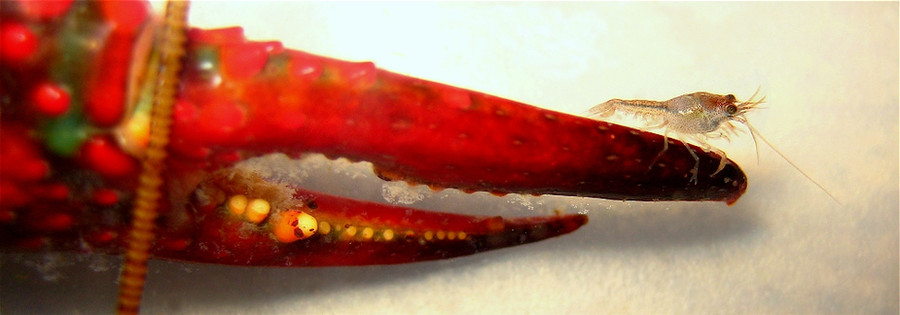HOME | DD
 Scutigera — Where did mom go
Scutigera — Where did mom go

Published: 2011-08-20 22:41:37 +0000 UTC; Views: 2430; Favourites: 26; Downloads: 16
Redirect to original
Description
This is an old photo I took when my original pair of crayfish (Rosen the Bonecrusher and Rufus the Adequate) bore dozens of offspring. The juvenile crayfish in this picture is about a week old, and is climbing atop one of its mother Rosen's chelipeds. Ideally this picture would have a better background and more diffuse lighting, but I like it because of the way it conveys the huge difference in size between a newly-hatched crayfish and a full-grown adult.The clumpy white growths on the sides of Rosen's claw are colonial protozoans, possibly Carchesium.
Related content
Comments: 17

It's funny to see how such a large an gnarly looking crustacean would have to care for such tiny and fragile babies.
👍: 0 ⏩: 0

This is just too cute, aww her beautiful little baby sitting on her claw like that, and you can see its little pincers too 
👍: 0 ⏩: 0

Whee so cute! I love the size difference, and the title.
And protozoans are pretty cool, too.
👍: 0 ⏩: 1

Thanks! I wish deviantart allowed punctuation in submission titles, because the title could really use a question mark.
👍: 0 ⏩: 0

Precious! Is it hard to get crayfish to reproduce?...Or rather in a tank full of fish, is it hard for the offspring to reach maturity?
👍: 0 ⏩: 1

I'm no expert crayfish breeder, but based on my experience, getting crayfish to reproduce isn't the hard part. I'd walk in on Rosen and Rufus going at it several times a week. But while it is easy to get crayfish to mate and lay eggs, it is not so easy to ensure the long-term survival of the offspring. Crayfish eggs often get infected and destroyed by a fungus that appears as a fuzzy whitish growth. A large proportion of Rosen's eggs were eliminated this way, yet enough eggs escaped infection to yield about 70 hatchlings. However, crayfish are notoriously cannibalistic, and the young risk being eaten by their siblings and their parents. They are especially vulnerable just after molting--and the younger a crayfish is, the more frequently it molts. Most of the hatchlings I had didn't survive longer than two or three months.
👍: 0 ⏩: 1

Man, life is pretty rough for larval crayfish, huh? Interesting stuff!
👍: 0 ⏩: 1

Indeed. Crayfish, like many crustaceans, have R-selected survivorship: young are small and likely to perish, so the solution is to produce hundreds of them and hope a few survive to adulthood.
👍: 0 ⏩: 1

They sure do! The male crayfish uses his own claws to clamp the female's claws shut and then the two crayfish press their ventral surfaces together and after that I'm fuzzy on the exact details but I know the male's claspers (modified first pleopods) are involved somehow.
👍: 0 ⏩: 0

That is ADORABLE. What a special little moment.
I really like the shape/framing of this- it makes the red shape of the claw create some lovely shapes on the pale background.
👍: 0 ⏩: 1

Thanks! In the original photo, you can see more of the antenna and some of Rosen's face at the top. I chose to crop it to a horizontal composition to focus on the claw and its passenger.
👍: 0 ⏩: 1

Yeah, it's a really nice choice of crop. It's amazing what that can do to a picture.
👍: 0 ⏩: 0

So so cute ;;
And those protozoans are fascinating!
👍: 0 ⏩: 1

Indeed. At first they look like algae, but closer observation reveals that they have a decidedly non-algae-like cup-on-stalk structure. I've observed similar-looking protozoan colonies attached to the exoskeletons of aquatic insects like water scorpions and dragonfly nymphs. They might be a type of Carchesium.
👍: 0 ⏩: 1

neat!
I'd love to culture macroscopic protozoa, I've heard of visible amoeba...
👍: 0 ⏩: 0





























